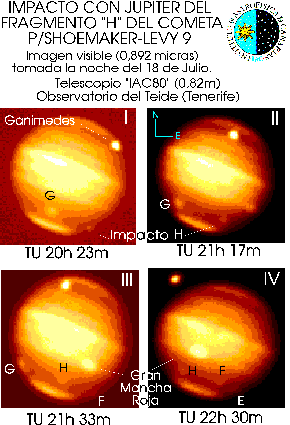

NOTE: Click on the image to view it at its highest resolution.
The detection of a new impact with the telescopes of the Instituto de Astrofisica de Canarias installed in Teide Observatory
Around 19:26UT (20:26 BST, 21:26 CET), Fragment H (14) of Comet Shoemaker-Levy impacted with Jupiter. the Carlos Sanchez Telescope (1.52m infrared telescope) and IAC-80 (an 82cm optical telescope) detected the explosion when it reached the edge of the disc of the planet at 20:07UT. The mark left by the explosion was almost as large as the Great Red Spot, that's to say, some 20 thousand Kilometers in length.
Unlike the impact of Fragment A last Saturday, the explosion of Fragment H was immediately visible through a filter tuned to the wavelength of methane gas, when it reached the edge of the disc. the impact zone was immediately visible without having to process the images. The brightness of the visible cloud was clearly superior to that of Fragment A, which is logical given that Fragment H was one of the larger ones in the comet.
As on previous occasions, the clouds were seen to project a considerable distance from the edge of the planet, showing once more that they are at a very considerable altitude in the atmosphere, well above the visible bands.
The infrared observations have confirmed the data obtained from visible observations, showing, above all, the majestic procession of the cloud from Fragment G, followed by the other, smaller clouds. As with the visible methane filter, the spots are seen to be bright in the infrared as observed with the infrared camera of the Carlos Sanchez Telescope.
Members of observation team, all from Instituto de Astrofisica de Canarias: P. Hammersly, M. Serra-Ricart, Nicholas Devaney, I. Vidal, J.M. Rodriguez-Espinosa, P.L. Palle, M. Kidger, J.J. Fuensalida